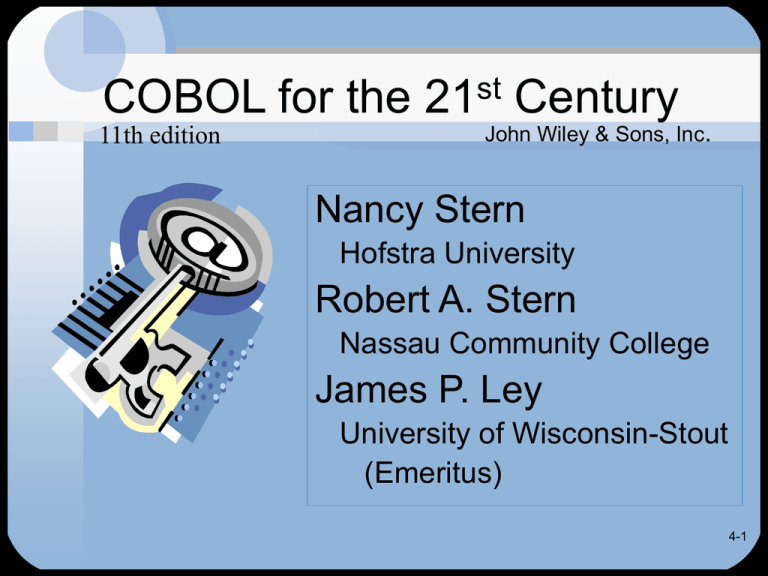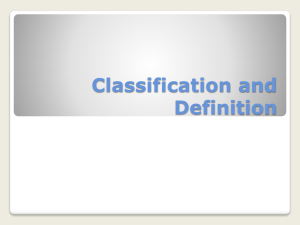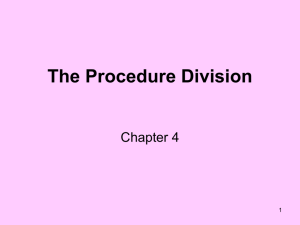
COBOL for the 21st Century
11th edition
John Wiley & Sons, Inc.
Nancy Stern
Hofstra University
Robert A. Stern
Nassau Community College
James P. Ley
University of Wisconsin-Stout
(Emeritus)
4-1
Chapter 4
Coding Complete COBOL
Programs: The PROCEDURE
DIVISION
4-2
Chapter Objectives
To familiarize you with methods used to
1. Access input and output files
2. Read data from an input file
3. Perform simple move operations
4. Write information to an output file
5. Accomplish end-of-job operations
6. Execute paragraphs from main module,
return control to that main module
4-3
Review of Data Division
• DATA DIVISION
– FILE SECTION
• Detailed description of input/output records
– WORKING-STORAGE SECTION
• Defines keyed input, displayed output
• Defines fields needed for processing but not
part of input/output records
4-4
PROCEDURE DIVISION
Contains instructions to
• Read data
• Process data
• Produce output
• Perform end-of-job operations
4-5
PROCEDURE DIVISION
• Interactive processing instructions
– Accept input from keyboard
– Display output on screen
• Batch processing instructions
– Access files and read them
– Write output to files
4-6
Paragraphs
• PROCEDURE DIVISION divided into
paragraphs
• Each is independent module or routine
• Made up of series of instructions to
perform specific set of operations
4-7
Rules for Paragraph-Names
• Coded in Area A, followed by period
• Follow rules for forming data-names
except may be all digits
– 1010, 1020, 1030, etc. are valid paragraph
names, but NOT RECOMMENDED
• Must be unique
4-8
Procedure Division Statements
• All statements coded in Area B
• Statement begins with verb (READ,
MOVE)
• Last statement in paragraph ends with
period
• Sentence - series of statements ending
with period
4-9
Batch Program Instructions
• OPEN - to open files to be processed
• PERFORM UNTIL … END-PERFORM
– Loop to continually READ and process
input records and WRITE results to output
file until there are no more records
• CLOSE - to close files when done processing
• STOP RUN - to end program
4-10
OPEN Statement
• Accesses and makes files available for
processing
• Identifies whether files will be used for
input or output
4-11
OPEN Statement
FORMAT
OPEN
INPUT
file-name-1 …
OUTPUT file-name-2 …
• File-names used must appear in SELECT
statement
• File must be accessed with OPEN before
reading from or writing to it
4-12
OPEN statement example
• May use a single OPEN statement
Open Input Payroll-File-In
Output PayChecks-File-Out,
Err-List-File-Out
• May use multiple OPEN statements,
but NOT RECOMMENDED
Open Input Payroll-File-In
Open Output PayChecks-File-Out
Open Output Err-List-File-Out
4-13
PERFORM UNTIL … END-PERFORM
FORMAT
PERFORM UNTIL condition-1
statement-1 ...
[END-PERFORM]
• Repeatedly executes statement(s)
between PERFORM UNTIL … ENDPERFORM until condition specified in
UNTIL clause is met
4-14
PERFORM UNTIL … END-PERFORM
• In typical batch program, instructions
repeated until no more records in file
• When condition met, program continues with
statement following END-PERFORM
4-15
PERFORM UNTIL … END-PERFORM
EXAMPLE
Perform Until WS-More-Data = 'NO'
Read Payroll-File-In
At End
Move 'NO' To WS-More-Data
Not At End
Perform 200-Process-Record
End-Read
End-Perform
4-16
PERFORM UNTIL … END-PERFORM
• Assume WS-More-Data initially = 'YES'
– Condition not met, so statements in PERFORM
loop will be executed
• WS-More-Data set to 'NO' when MOVE
statement executed
– When condition checked again loop ends since
condition has been met
4-17
READ Statement
• Reads record from file opened for input
• Transfers record to input storage area
• Makes one record available at a time,
not entire file
4-18
READ Statement
•
FORMAT
READ file-name-1
AT END statement-1 …
[NOT AT END statement-2 …]
[END-READ]
• File-name appears in SELECT
statement, FD entry and OPEN
• AT END tests if there are more records
4-19
READ Statement
• If no more records
– Executes statement(s) after AT END
– Typically statement(s) to cause loop
containing READ to end
• If more records
– Reads in next record
– Executes statement(s) after NOT AT END
– Typically statement(s) to process record
just read
4-20
Simple PERFORM
FORMAT
PERFORM paragraph-name
• To execute instructions in separate paragraph
or module one time
• Transfers control to named paragraph
• Executes all instructions in paragraph
• Control returns to statement following
PERFORM
4-21
Out-Of-Line PERFORM
FORMAT
PERFORM paragraph-name
UNTIL condition
• Repeats paragraph until condition met
• Control transfers to named paragraph
• Executes instructions in paragraph and
returns
4-22
In-Line PERFORM
FORMAT
PERFORM UNTIL condition
statement(s)
END-PERFORM
• Repeats statement(s) until condition met
• Statement(s) to be executed are in-line, not in
separate paragraph
4-23
End-Of-Job Processing
• Steps performed after all records
processed
• Release all files
• Terminate processing
4-24
CLOSE statement
•
FORMAT
CLOSE file-name-1 ...
• Close all files opened
• Indicates files no longer needed for
processing
• Releases files and deactivates devices
4-25
Closing multiple files
• May use a single CLOSE statement
Close Payroll-File-In
PayChecks-File-Out
Err-List-File-Out
• May use multiple CLOSE statements,
but NOT recommended
Close Payroll-File-In
Close PayChecks-File-Out
Close Err-List-File-Out
4-26
STOP RUN
• Terminates the program
• Usually last instruction in main module
• Execution continues with next
paragraph if STOP RUN is omitted
4-27
MOVE statement
•
FORMAT
MOVE identifier-1 TO identifier-2
• Copies contents of identifier-1 to
identifier-2
4-28
WRITE statement
•
FORMAT
WRITE record-name-1
• Transmits data from output record area
to associated file on device specified
• Record-name is 01 level name following
FD for a file opened for output
• READ file-name, WRITE record-name
4-29
Comments in COBOL
• Start with asterisk (*) in column 7
• Use as reminders and explanations of
processing performed by program
• Use to describe program in
IDENTIFICATION DIVISION
• Use to describe each module in
PROCEDURE DIVISION
4-30
Batch Programs Review
• Programs that process large quantity of
data stored in files
• Require ENVIRONMENT DIVISION
• Require FILE SECTION in DATA
DIVISION
• Use OPEN, READ, WRITE, CLOSE
verbs to process files
4-31
Chapter Summary
• Batch Program Structure
– Main module's in-line PERFORM UNTIL
repeatedly executes READ statement
– READ gets and processes next record until
there are no more
– Files are opened before PERFORM loop
and closed after loop ends
4-32
Chapter Summary
• Paragraph-names coded in Area A and
end with period
• All other PROCEDURE DIVISION
statements coded in Area B
• Statements executed in order unless
– PERFORM UNTIL loop executes
– PERFORM transfers control to another
paragraph
4-33
Copyright © 2003 John Wiley & Sons, Inc. All rights reserved.
Reproduction or translation of this work beyond that permitted in Section
117 of the 1976 United States Copyright Act without the express written
permission of the copyright owner is unlawful. Request for further
information should be addressed to the Permissions Department, John
Wiley & Sons, Inc. The purchaser may make back-up copies for his/her
own use only and not for distribution or resale. The Publisher assumes no
responsibility for errors, omissions, or damages, caused by the use of these
programs or from the use of the information contained herein.
Limited modifications to original presentation.
4-34












